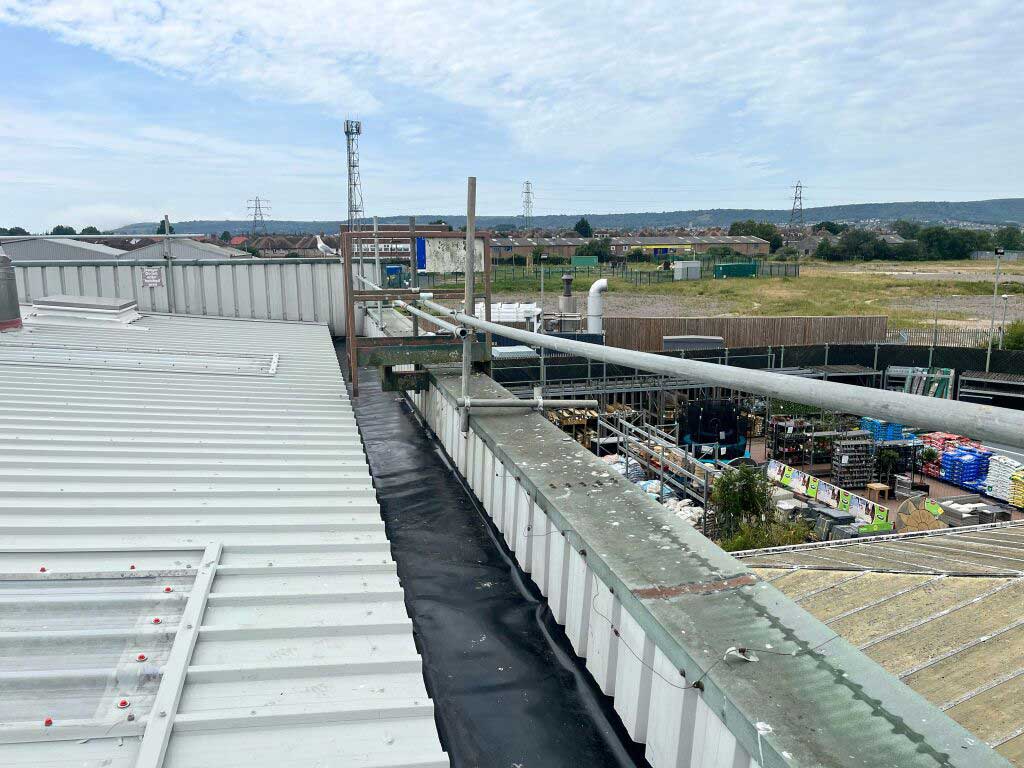
When you think of roof failure in a commercial building, you probably imagine a leak dripping onto the office floor. But here’s the reality: leaks are usually the last stage of roof failure. By the time water has made its way into your building, the damage is already advanced and costly.
That’s why property managers, facility owners, and business operators need to look for the early signs of roof trouble—signs that often go unnoticed because they don’t involve visible water. Identifying these problems before they escalate can save you thousands in repairs, prevent business disruptions, and extend the life of your commercial roof.
Below are six of the most common warning signs of roof failure that aren’t leaks.
1. Pooling or Standing Water
Flat and low-slope roofs are designed with drainage systems that keep water moving. When you see puddles that remain for more than 48 hours after a storm, it’s a red flag.
Why it matters:
-
Water adds weight and stresses the roof deck.
-
Persistent moisture accelerates membrane breakdown.
-
Standing water attracts dirt, algae, and vegetation growth, which further weakens the surface.
Pooling often points to clogged drains, insufficient slope, or structural issues—all of which can lead to leaks and even roof collapse if left unchecked.
2. Blistering, Bubbling, or Cracking Membranes
Commercial roofing membranes—TPO, EPDM, PVC, modified bitumen, or BUR—can form blisters when air or moisture gets trapped under the surface. These bubbles or raised areas may look small, but they signal compromised adhesion.
Why it matters:
-
Blisters can rupture, exposing the insulation below.
-
Cracking membranes allow UV radiation and water intrusion.
-
The problem typically spreads, weakening large sections of the roof.
Catching membrane damage early is critical, since replacement of localized areas is far less costly than replacing an entire roof.
3. Damage Around HVAC Units and Roof Penetrations
Every HVAC unit, vent, pipe, or skylight installed on a commercial roof represents a potential weak spot. Flashings and sealants are designed to protect these areas, but they degrade over time.
Warning signs:
-
Loose or torn flashing
-
Cracks in the material around penetrations
-
Rust or corrosion near units
Even if water hasn’t entered yet, these breaches reduce energy efficiency and create open paths for leaks in the next heavy rain.
4. Rising Energy Bills
A sudden spike in utility costs isn’t always caused by HVAC inefficiency—it can be your roof.
When insulation becomes wet or roof membranes are compromised, conditioned air escapes while outside air sneaks in. This forces heating and cooling systems to run longer and harder.
Signs to look for:
-
Higher bills despite stable usage
-
Temperature fluctuations in certain areas of the building
-
HVAC systems cycling more often
Addressing roof insulation and sealing issues can quickly return energy costs to normal.
5. Interior Warning Signs (Without Visible Leaks)
Not all moisture problems show up as dripping water. Sometimes, the signs are subtler.
Examples:
-
Stained ceiling tiles
-
Musty odors in certain rooms
-
Unexplained humidity or condensation on windows
-
Peeling paint or bubbling drywall
These often indicate moisture has already penetrated the roof system and is affecting insulation or ceiling materials—even if you don’t see active leaks.
6. Visible Sagging or Uneven Roof Surfaces
Walk your roof and look for low spots, rippling, or sagging areas. These are signs that the roof deck or insulation below may be saturated with water or structurally compromised.
Why it matters:
-
Waterlogged insulation loses all thermal value.
-
Sagging surfaces increase water pooling.
-
Severe sagging may signal structural weakening that could lead to partial collapse.
This is one of the most dangerous signs of roof failure and demands immediate inspection.
Why Early Detection Matters
The earlier you spot roof failure, the easier it is to address. Waiting until leaks appear usually means replacing large roof sections—or the entire system.
Benefits of early action:
-
Lower repair and maintenance costs
-
Extended roof lifespan
-
Reduced risk of business interruption
-
Better energy efficiency and lower utility bills
Routine inspections by a qualified roofing contractor are the best way to catch these warning signs before they escalate.
Final Takeaway
Leaks may be the most obvious sign of roof failure, but they’re far from the first. Pooling water, blistering membranes, HVAC-related damage, rising energy bills, interior moisture indicators, and sagging roof surfaces are all early red flags that deserve immediate attention.
Don’t wait for water to start dripping on your floors. A proactive approach to roof maintenance saves money, protects your investment, and keeps your business running without costly surprises.






